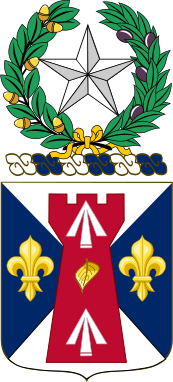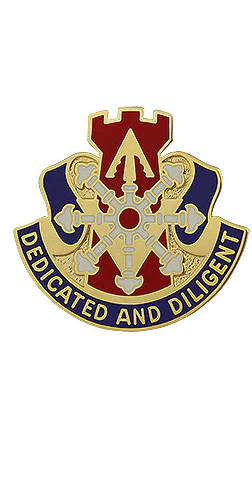About 111th Engineer Battalion111th Engineer Battalion
MOTTO: "Fortis et Fidelis" "Brave and Faithful"
The origins of the 111th date back to Company A, Texas Engineers, was organized in Port Arthur in 1916, followed by Company B shortly after, redesignated from artillery to engineers. The entire Texas engineer unit was called to federal service on August 15, 1917. The Engineers were redesignated as the 111th Engineer Regiment in October, 1917 with the First Oklahoma Engineer battalion included to form second battalion of the regiment. Included in the ranks of the 111th were "400 cowboys", including most of Company C, First Battalion, from Sweetwater. The unit completed the work begun at Camp Bowie, building a road system and the "Benbrook trench system". The Benbrook trenches stretched, upon completion, for more than ten miles along both sides of the Texas and Pacific Railroad southwest of Fort Worth.
The was called upon for service in the World War and arrived in France in July, 1918, assigned with the 36th Division to the Bar-sur-Aube, assigned Corps Engineers for the First Corps in September, repairing roads, filling captured trenches and building bridges. The regiment spent most of October following the American advance, providing vital road building work as the armies advanced, ending the war near Sedan. Clearing German mines in the line of advance was a particularly dangerous part of the work of the unit. The unit was mustered out of service at Camp Bowie, Fort Worth, Texas, in May, 1919 and reorganized as an all-Texas unit, 1922.
The Regiment was inducted into federal service for the Second World War as part of the 36th Division at Fort Worth, Texas, and moved to Camp Bowie, Brownwood, Tx, where 1st Bn was redesignated 111th Engineer Battalion (Combat) and 2d Bn was resdesignated 2d Bn 176th Engineers on 31 Jan 42. The 111th trained with the 36th and made overseas deployment from New York on 2 April 1943, arriving in North Africa on 13 April, 1943. Landed at the Salerno Beachhead, 9 September, 1943, and accompanied the 36th Division as Division Engineers in the landings in Southern France, 15 August, 1944, the Loire Valley, Vosges, Alsace, and the Danube Valley, ending the war near the German Austrian border on 7 May, 1945. The unit was awarded campaign credit for Naples-Foggia, Anzio, Rome-Arno, Southern France, Ardennes, Alsace, and Central Europe. The unit returned to the United States in December, 1945 and was deactivated at Camp Miles Standish, Massachusetts, on 26 December, 1945.
When the 36th Infantry Division was reconstituted in Texas in 1947, the 111th Engineer Combat Battalion was reactivated, serving as a unit of the 36th until the division was deactivated in 1968. Elements of the 111th and 386th Engineer Battalions were redesignated as the 236th, 271st and 272d Engineer Companies when the 36th and 49th Divisions were deactivated. Headquarters and Headquarters Company of the 111th, with the 342 Engineer Company and the 231st Engineer Company were retained as State Troop Command Units. The 111th Engineer Battalion was reconstituted in 1973 as an element of the 49th Armored Division upon the reactivation of the Division. Today the battalion is an element of the 36th Infantry Division.
The 111th Engineer Battalion recently deployed to Afghanistanin in 2011 in support of Operation Enduring Freedom and served overseas for nearly a year before returning home to Brownwood.
Unit Crest: Distinctive Unit Insignia:


Approved on 11 June 1971, the 111th Engineer Bat-talion Distinctive Unit Insignia, also known as a unit crest, pays tribute to the service of predecessor units in the Battalion’s lineage. In the center is an escarbuncle, a heraldic charge with eight radiating spokes, four of which make a standard cross and the other four forming a saltire. Here, only seven spoke are visible; this is an allusion to seven European campaign streamers awarded while the unit was still a Field Artillery organization with 36th Infantry Division in World War II.
Two arrowheads (“pheons” in heraldry) are a reference to the Arrowhead device awarded for participating in an assault landing; the golden arrow pointing down simulates the letter “V” for Vosges and is a reference to the French Croix de Guerre with Palm awarded for action near there. A red tower is a traditional Corps of Engineers symbol.